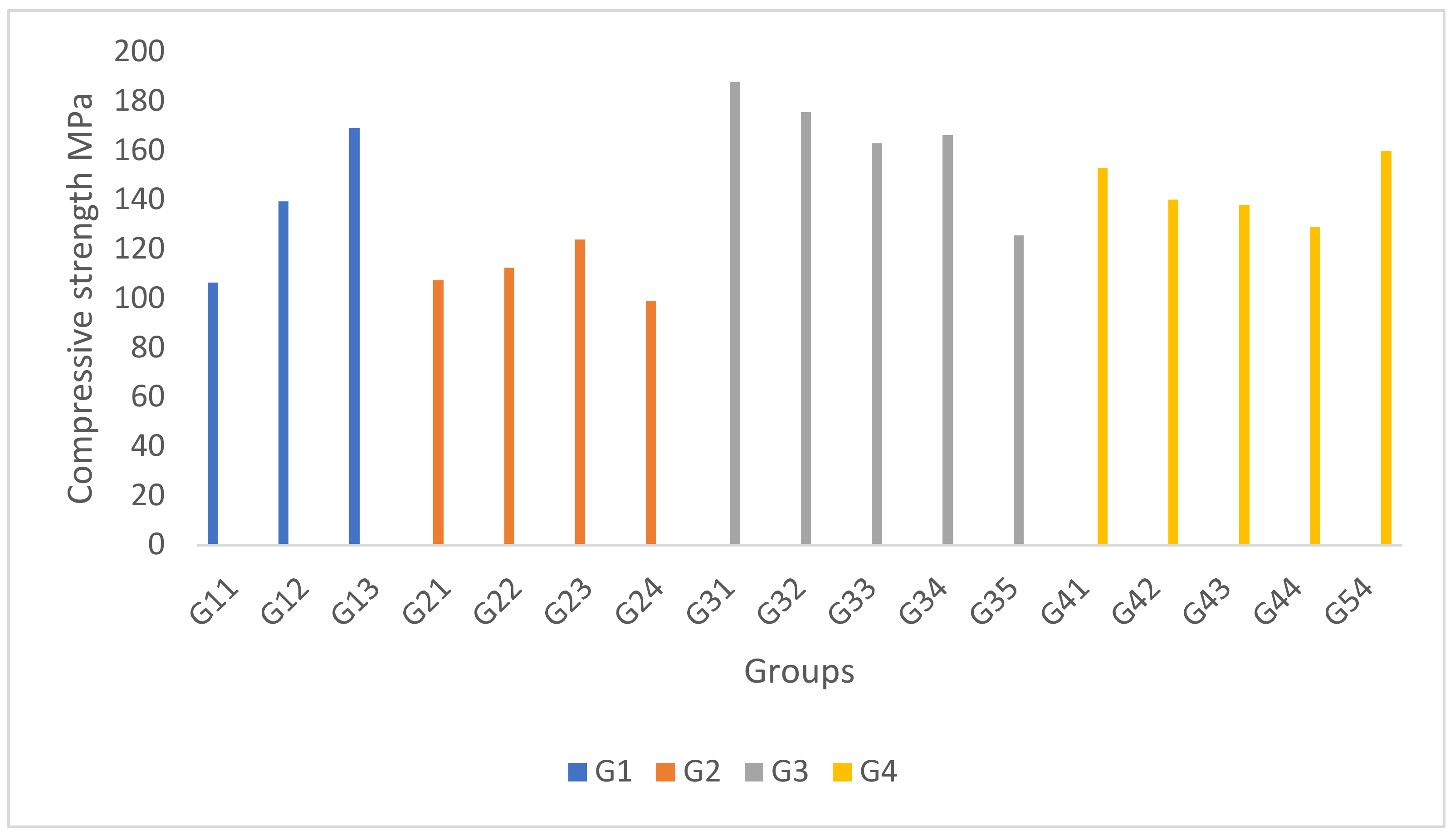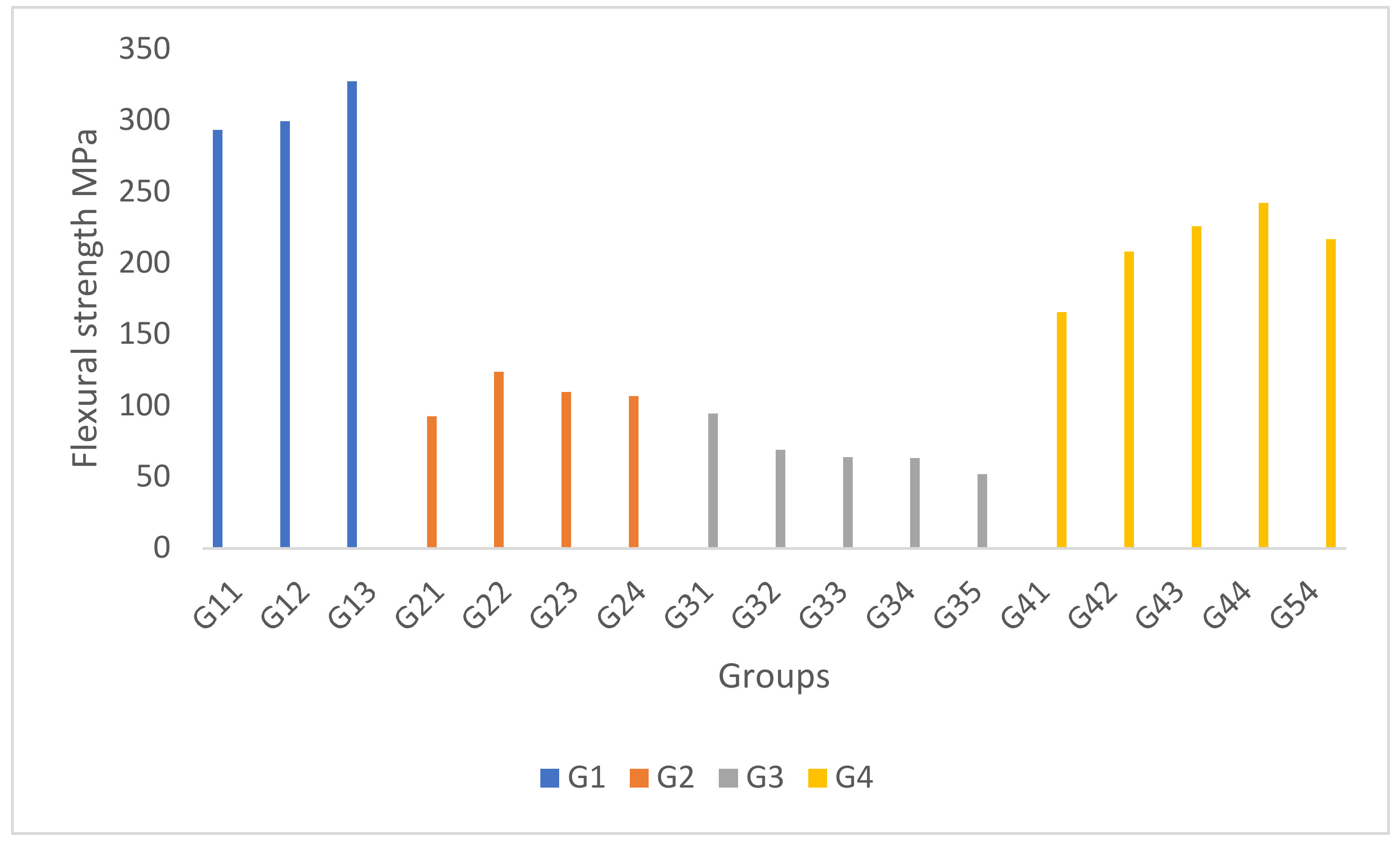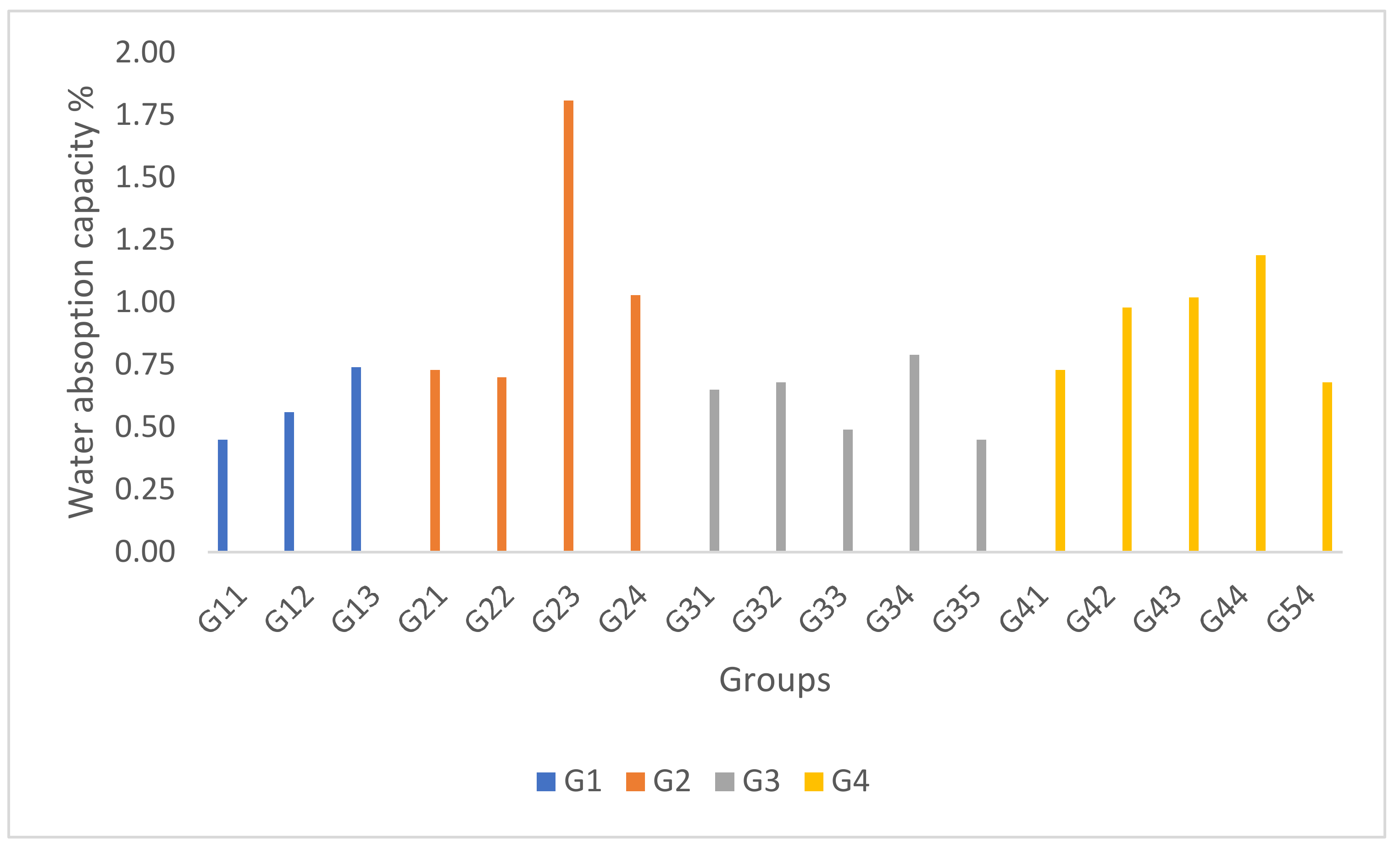Mechanical Properties and Water Absorption Capacity of Hybrid GFRP Composites
Abstract
1. Introduction
2. Materials and Methods
2.1. Materials
2.2. Fabrication of Hybrid GFRP Composite
2.3. Mechanical Testing and Water Absorption Capacity
3. Results and Discussion
3.1. Tensile Strength
3.2. Compressive Strength
3.3. Flexural Strength
3.4. Water Absorption Capacity
4. Techno-Economics Aspects
5. Conclusions
Author Contributions
Funding
Institutional Review Board Statement
Informed Consent Statement
Data Availability Statement
Conflicts of Interest
References
- Saba, N.; Paridah, M.T.; Jawaid, M. Mechanical properties of kenaf fibre reinforced polymer composite: A review. Constr. Build. Mater. 2015, 76, 87–96. [Google Scholar] [CrossRef]
- FEMA. Flood Damage-Resistant Materials Requirements; Technical Bulletin 2; FEMA: Washington, DC, USA, 2008. [Google Scholar]
- Reddy, G.; Krishna, V.; Shanker, K. Tensile and Water Absorption Properties of FRP Composite Laminates without Voids and with Voids. Procedia Eng. 2017, 173, 1684–1691. [Google Scholar] [CrossRef]
- Chakraverty, A.P.; Mohanty, U.K.; Mishra, S.C.; Satapathy, A. Sea water ageing of GFRP composites and the dissolved salts. IOP Conf. Ser. Mater. Sci. Eng. 2015, 75, 012029. [Google Scholar] [CrossRef]
- Raja, R.S.; Manisekar, K.; Manikandan, V. Study on mechanical properties of fly ash impregnated glass fiber reinforced polymer composites using mixture design analysis. Mater. Des. 2014, 55, 499–508. [Google Scholar] [CrossRef]
- Sravani, K.S.; Reddy, B.R.G.; Mohammed, R. Effect of CaCO3 and Al2O3 Fillers on Mechanical Properties of Glass/Epoxy Composites. Int. J. Mod. Trends Sci. Technol. 2017, 3, 207–214. [Google Scholar]
- Sapiai, N.; Jumahat, A.; Jawaid, M.; Midani, M.; Khan, A. Tensile and flexural properties of silica nanoparticles modified unidirectional kenaf and hybrid glass/kenaf epoxy composites. Polymers 2020, 12, 2733. [Google Scholar] [CrossRef] [PubMed]
- Adeniyi, A.G.; Onifade, D.V.; Ighalo, J.O.; Adeoye, A.S. A review of coir fiber reinforced polymer composites. Compos. Part B Eng. 2019, 176, 107305. [Google Scholar] [CrossRef]
- Lekube, B.M.; Hermann, W.; Burgstaller, C. Partially compacted polypropylene glass fiber non-woven composite: Influence of processing, porosity and fiber length on mechanical properties and modeling. Compos. Part A Appl. Sci. Manuf. 2020, 135, 105939. [Google Scholar] [CrossRef]
- Bhagat, V.K.; Biswas, S.; Dehury, J. Physical, Mechanical, and Water Absorption Behavior of Coir/Glass Fiber Reinforced Epoxy Based Hybrid Composites. Polym. Compos. 2014, 35, 925–930. [Google Scholar] [CrossRef]
- Quino, G.; Tagarielli, V.L.; Petrinic, N. Effects of water absorption on the mechanical properties of GFRPs. Compos. Sci. Technol. 2020, 199, 108316. [Google Scholar] [CrossRef]
- Chellamuthu, K.; Vasanthanathan, A. Experimental analysis of GFRP with PET for tensile load and water absorption. Mater. Today Proc. 2020, 21, 658–662. [Google Scholar] [CrossRef]
- Al-Sabagh, A.; Taha, E.; Kandil, U.; Awadallah, A.; Nasr GA, M.; Reda Taha, M. Monitoring moisture damage propagation in GFRP composites using carbon nanoparticles. Polymers 2017, 9, 94. [Google Scholar] [CrossRef] [PubMed]
- Alam, M.S.; Chowdhury, M.A. Characterization of epoxy composites reinforced with CaCO3-Al2O3-MgO-TiO2/CuO filler materials. Alex. Eng. J. 2020, 59, 4121–4137. [Google Scholar] [CrossRef]
- Abdi, A.; Eslami-Farsani, R.; Khosravi, H. Evaluating the Mechanical Behavior of Basalt Fibers/Epoxy Composites Containing Surface-modified CaCO3 Nanoparticles. Fibers Polym. 2018, 19, 635–640. [Google Scholar] [CrossRef]
- Aparna, S.; Sathyan, D.; Anand, K.B. Microstructural and rate of water absorption study on fly-ash incorporated cement mortar. Mater. Today Proc. 2018, 5, 23692–23701. [Google Scholar] [CrossRef]
- Ramesh, P.; Prasad, B.D.; Narayana, K.L. Characterization of kenaf fiber and its composites: A review. J. Reinf. Plast. Compos. 2018, 37, 731–737. [Google Scholar] [CrossRef]
- Bajuri, F.; Mazlan, N.; Ishak, M.R. Water absorption analysis on impregnated kenaf with nanosilica for epoxy/kenaf composite. IOP Conf. Ser. Mater. Sci. Eng. 2018, 405, 012013. [Google Scholar] [CrossRef]
- Manap, N.; Jumahat, A.; Sapiai, N. Effect of nanosilica content on longitudinal and transverse tensile properties of unidirectional kenaf composite. J. Teknol. 2015, 11, 87–95. [Google Scholar] [CrossRef][Green Version]
- Yahaya, R.; Sapuan, S.M.; Jawaid, M.; Leman, Z.; Zainudin, E.S. Water absorption behaviour and impact strength of Kenaf-Kevlar reinforced epoxy hybrid composites. Adv. Compos. Lett. 2016, 25, 98–102. [Google Scholar] [CrossRef]
- Asyraf, M.R.M.; Ishak, M.R.; Syamsir, A.; Nurazzi, N.M.; Sabaruddin, F.A.; Shazleen, S.S.; Norrrahim, M.N.F.; Rafidah, M.; Ilyas, R.A.; Rashid, M.Z.A.; et al. Mechanical properties of oil palm fibre-reinforced polymer composites: A review. J. Mater. Res. Technol. 2022, 17, 33–65. [Google Scholar] [CrossRef]




| Group | Sample | Designation | Composition wt. % | ||||||
|---|---|---|---|---|---|---|---|---|---|
| Glass Fabric | Resin | Kenaf Fibre | Coconut Fibre | Fly Ash | Nano Silica | CaCO3 | |||
| G1 | G11 | 30G-50R-15F-5CaCO3-GFRP | 30 | 50 | - | - | 15 | - | 5 |
| G12 | 30G-50R-10F-10CaCO3-GFRP | 30 | 50 | - | - | 10 | - | 10 | |
| G13 | 30G-50R-5F-15CaCO3-GFRP | 30 | 50 | - | - | 5 | - | 15 | |
| G2 | G21 | 40G-50R-9.75K-0.25N-GFRP | 40 | 50 | 9.75 | - | - | 0.25 | - |
| G22 | 40G-50R-9.5K-0.5N-GFRP | 40 | 50 | 9.5 | - | - | 0.5 | - | |
| G23 | 40G-50R-9.25K-0.75N-GFRP | 40 | 50 | 9.25 | - | - | 0.75 | - | |
| G24 | 40G-50R-9K-1N-GFRP | 40 | 50 | 9 | - | - | 1 | - | |
| G3 | G31 | 10G-60R-15C-15F-GFRP | 10 | 60 | - | 15 | 15 | - | - |
| G32 | 10G-60R-22.5C-7.5F-GFRP | 10 | 60 | - | 22.5 | 7.5 | - | - | |
| G33 | 10G-60R-7.5C-22.5F-GFRP | 10 | 60 | - | 7.5 | 22.5 | - | - | |
| G34 | 10G-60R-30C-GFRP | 10 | 60 | - | 30 | - | - | - | |
| G35 | 10G-60R-30F-GFRP | 10 | 60 | - | - | 30 | - | - | |
| G4 | G41 | 20G-60R-5K-15CaCO3-GFRP | 20 | 60 | 5 | - | - | - | 15 |
| G42 | 20G-60R-10K-10CaCO3-GFRP | 20 | 60 | 10 | - | - | - | 10 | |
| G43 | 20G-60R-15K-5CaCO3-GFRP | 20 | 60 | 15 | - | - | - | 5 | |
| G44 | 20G-60R-20K-GFRP | 20 | 60 | 20 | - | - | - | - | |
| G45 | 20G-60R-20CaCO3-GFRP | 20 | 60 | - | - | - | - | 20 | |
| Property | G1 | G2 | G3 | G4 |
|---|---|---|---|---|
| Tensile strength | Tensile strength increased when CaCO3 increased and fly ash decreased. | Tensile strength increased when nano silica increased, and kenaf fibre decreased. | Tensile strength increased when fly ash increased, and coconut fibre decreased. | Tensile strength increased when kenaf fibre increased and CaCO3 decreased. |
| Compressive strength | Compressive strength increased when CaCO3 increased and fly ash decreased. | Compressive strength increased, nano silica increased, and kenaf fibre decreased. | Compressive strength decreased when fly ash increased, and coconut fibre decreased. | Compressive strength decreased when kenaf fibre increased, and CaCO3 decreased. |
| Flexural strength | Flexural strength increased when CaCO3 increased and fly ash decreased. | Flexural strength increased when nano silica increased, and kenaf fibre decreased. | Flexural strength decreased when fly ash increased, and coconut fibre decreased. | Flexural strength increased when kenaf fibre increased and CaCO3 decreased. |
| Water absorption capacity | Water absorption capacity increased when CaCO3 increased and fly ash decreased. | Water absorption capacity showed irregular results. | Water absorption capacity increased when fly ash decreased and coconut fibre increased. | Water absorption capacity increased when kenaf fibre increased, and CaCO3 decreased. |
Publisher’s Note: MDPI stays neutral with regard to jurisdictional claims in published maps and institutional affiliations. |
© 2022 by the authors. Licensee MDPI, Basel, Switzerland. This article is an open access article distributed under the terms and conditions of the Creative Commons Attribution (CC BY) license (https://creativecommons.org/licenses/by/4.0/).
Share and Cite
Wan Badaruzzaman, W.H.; Dabbagh, N.M.R.; Salleh, K.M.; Saharuddin, E.N.; Mat Radzi, N.F.; Azham, M.A.A.; Abdullah Sani, S.F.; Zakaria, S. Mechanical Properties and Water Absorption Capacity of Hybrid GFRP Composites. Polymers 2022, 14, 1394. https://doi.org/10.3390/polym14071394
Wan Badaruzzaman WH, Dabbagh NMR, Salleh KM, Saharuddin EN, Mat Radzi NF, Azham MAA, Abdullah Sani SF, Zakaria S. Mechanical Properties and Water Absorption Capacity of Hybrid GFRP Composites. Polymers. 2022; 14(7):1394. https://doi.org/10.3390/polym14071394
Chicago/Turabian StyleWan Badaruzzaman, Wan Hamidon, Noaman Mohammed Ridha Dabbagh, Kushairi Mohd Salleh, Esri Nasrullah Saharuddin, Nur Fashiha Mat Radzi, Mohd Amir Ashraff Azham, Shahrul Faizi Abdullah Sani, and Sarani Zakaria. 2022. "Mechanical Properties and Water Absorption Capacity of Hybrid GFRP Composites" Polymers 14, no. 7: 1394. https://doi.org/10.3390/polym14071394
APA StyleWan Badaruzzaman, W. H., Dabbagh, N. M. R., Salleh, K. M., Saharuddin, E. N., Mat Radzi, N. F., Azham, M. A. A., Abdullah Sani, S. F., & Zakaria, S. (2022). Mechanical Properties and Water Absorption Capacity of Hybrid GFRP Composites. Polymers, 14(7), 1394. https://doi.org/10.3390/polym14071394







